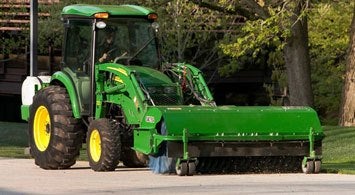
Rotary brooms have been around ever since man tired of pushing a hand broom and mechanical power became available. Today many types of sweepers and brooms are readily available, from walk-behind sidewalk sweepers to street sweepers to those propelled by ATV/UTVs, and yes, tractors.
Rotary brooms for tractors may be powered in a variety of ways, such as by the tractor engine/transmission using a gearbox driven by belt or chain, a driveshaft from the transaxle/transmission, by a hydraulic mower powered off the tractor hydraulic system, or even a separate pump powered by the tractor power take-off (PTO). Most units, when observed from the right side, will rotate clockwise (counterclockwise when viewed from the left), propelling debris forward, ahead of the tractor travel. Some units, though, are able to reverse broom rotation, allowing use against a building while the tractor backs up and “pulls” rather than pushes debris away.
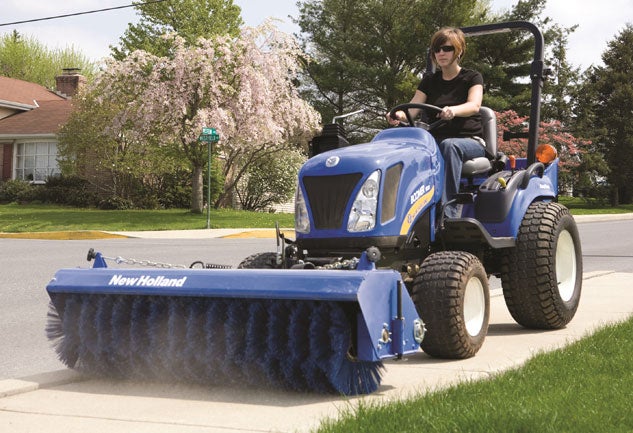
Mounting methods include systems that mount to a tractor loader boom, three-point hitch (3PH), and/or specialty mounts or quick hitches specific to the tractor used. Proper ballasting should be taken into consideration and many tractors will require suitcase weights, ballast box or an appropriate rear implement to keep adverse loads off the tractor and maintain traction.
Angling a rotary broom adds versatility by allowing the operator to direct the debris to the sides. On a small lawn tractor, changing angle might be accomplished by the operator getting off the tractor, pulling a pin and manually changing the angle. Some setups might use a manual crank to change angle. Others, such as found on larger lawn and garden tractors, subcompacts and compact tractors, may have hydraulically angling systems. On larger tractors, water dispensing systems might be part of the package and can help hold down dust.
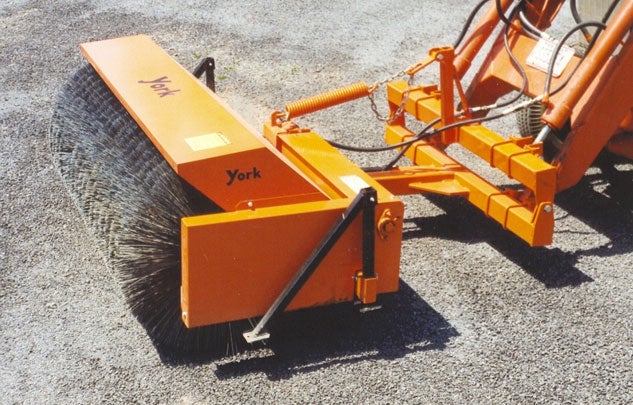
Storage stands are a must for rotary brooms, which otherwise would rest on the soft bristles making them prone to tipping over and also damaging (flattening) the bristles. Rotary brooms are also heavy, ranging from a few hundred pounds to much more depending on the size. A storage stand makes reattaching that mass all that much easier. Some rotary brooms have gauge wheels (see below) which can also aid in reattaching.
So what can a tractor-driven rotary broom be used for? Sweeping, of course. If your drive abuts a slope and the runoff after a rain ends up with a mess of dirt/debris covering the driveway, a rotary broom is an effective and effortless way of cleaning up. In the fall, when leaves collect on that drive, a rotary broom can windrow leaves for later pickup by a pull/tow-behind collection system. Pine needles create problems of their own. Collection systems notoriously struggle to pick the fine needles up. A rotary broom can be used to brush the needles into a pile better handled by a collection system or even onto a tarp to drag away.
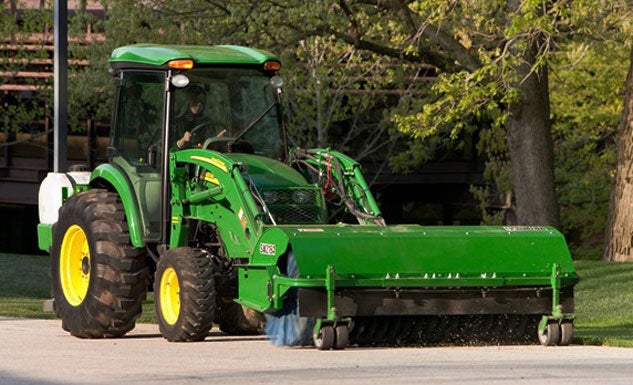
If plug aerating is on your once or twice yearly regimen, those pesky, ugly plugs eventually dissipate, but that process can take a week or two. A rotary broom can be used to help speed the process along, or even push the plugs into a pile where the turf can be reclaimed at a more convenient time. For the lawn thatch that builds up over time, a rotary broom can be used to help thin out that thatch. Don’t have a leaf collection system? No problem. A rotary broom can be used to push the leaves into a pile, while at the same time clearing your lawn of sticks, pebbles and stones, along with those pesky acorns that collection systems again struggle with.
For commercial users such as sprinkler system installers, a rotary broom can be used to backfill the cut trench. The same goes for any digging project whether it be commercial or homeowner – backfilling a hole is easier with a rotary broom. For properties with gravel drives, winter plowing/snow blowing provides another challenge when spring rolls around. Cleaning the lawn from the pushed/blown gravel is a slow, high effort process with a rake. If the ground is still frozen, a landscape rake (if available) can be used, but often the result is even more turf damage. A rotary broom excels at this task and is easy on that turf.
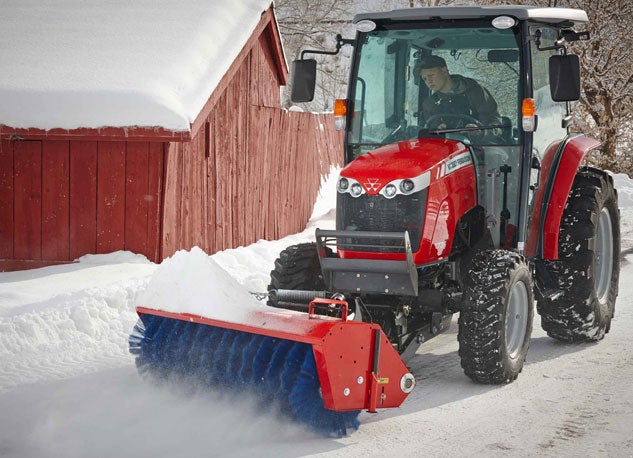
Snow removal is a task some might not associate with a rotary broom, but for snowfalls of 2” or less, a rotary broom can be effective at cleaning/clearing right down to the bare surface. For heavier snowfalls, most rotary brushes do lose effectiveness. For those situations, the operator would be well advised to keep up with the snowfall and most likely have to clean the surface several more times than with say a snow blower. Another nuance to be aware of is if a person or animal walks on the snow before it can be swept; under some conditions the footprint will freeze and when the rotary brush later goes over the print, will polish it to a mirror smoothness. In that case, going over the slippery footprints with sand, salt or a chemical such as magnesium chloride is a good idea. For a tractor with a front mounted rotary broom, having a rear PTO-driven spreader can make for a highly productive and efficient complement.
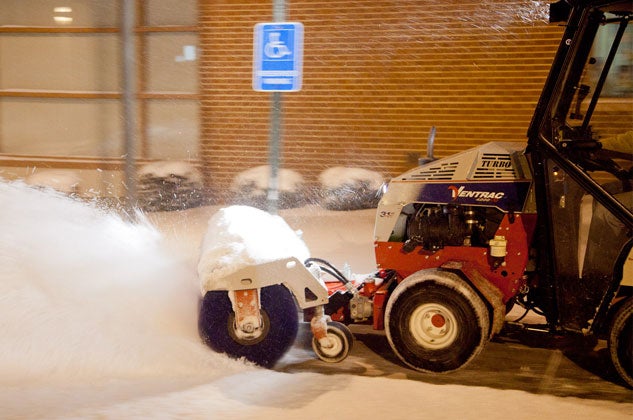
Lastly, many surfaces are fragile or easily damaged. With a rotary broom bristles set at the proper height, the cleaning action is gentle. How gentle? Gentle enough to be used on tennis courts, wood decking (assuming the structure will handle the tractor/broom weight), and even artificial turf.
As mentioned above, gauge wheels are available for most rotary brooms, and usually as a somewhat pricey option. Our recommendation is that a purchaser not skimp on this feature if at all possible. Gauge wheels help keep the weight, which sits far out front and effectively increases the load on the tractor frame, off that very frame. Gauge wheels also help maintain the right amount of pressure on the turf, increasing the rotary brush effectiveness while decreasing the wear on the bristles, which can be pricey to replace. And as pointed out above, gauge wheels can help with storage and implement reattachment.
Rotary Broom Pros
• Cleans right down to the set height
• Cleans right down to the surface
• Can be used on fragile surfaces
• Can be used on a variety of materials (gravel, mulch, dirt, leaves, thatch, snow etc.)
• When sized correctly, can be used on virtually any tractor
• Beats using a hand broom any day-anytime
Rotary Broom Cons
• Expensive. Figure all the running gear and hitch/linkages of a snow blower
• Replacement brushes can be expensive. Tip: check the aftermarket
• Take up storage space
• Another implement to service and maintain
• Can polish footprints and tire tracks to a slippery shine
• Added length to a tractor can make the entire package more difficult to get into close quarters
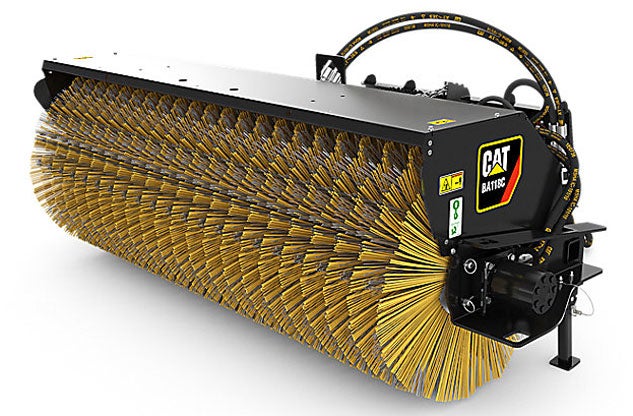
If we’ve piqued your interest in rotary brooms, start by stopping by your local dealer/retailer and see what options are available for your particular machine. If you’re on the fence, ask for the name of an existing rotary broom owners. Talking to that owner may help explain how few used rotary brooms at any given time seem to be available.
 Your Privacy Choices
Your Privacy Choices